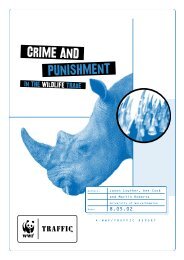Forest renaissance - The role of state forestry in Britain ... - WWF UK
Forest renaissance - The role of state forestry in Britain ... - WWF UK
Forest renaissance - The role of state forestry in Britain ... - WWF UK
You also want an ePaper? Increase the reach of your titles
YUMPU automatically turns print PDFs into web optimized ePapers that Google loves.
FOREST RENAISSANCE • THE ROLE OF STATE FORESTRY IN BRITAIN 1919-2050: A DISCUSSION PAPERForeword by David Bills,Director General, <strong>Forest</strong>ryCommission<strong>The</strong> future management <strong>of</strong> our forests sits atan important crossroads at the beg<strong>in</strong>n<strong>in</strong>g <strong>of</strong>the 21st century. <strong>The</strong> <strong>Forest</strong>ry Commission issplitt<strong>in</strong>g its GB <strong>Forest</strong> Enterprise to createthree new agencies, each dedicated tomanag<strong>in</strong>g the public woods and forests <strong>in</strong>England, Scotland and Wales. We believe thisaction <strong>in</strong> the spirit <strong>of</strong> devolution will providemore focused support for the three national<strong>forestry</strong> strategies.Our predecessors, <strong>in</strong> found<strong>in</strong>g the <strong>Forest</strong>ryCommission over 80 years ago – and thesubsequent generations <strong>of</strong> staff s<strong>in</strong>ce then –have passed on an extensive and varied legacy<strong>of</strong> forests across Great Brita<strong>in</strong>. I am veryencouraged, and I know many <strong>of</strong> our staff willbe too, by the recognition this report makesto the considerable achievements made overthe last 50 years, and particularly the changesthat have been made <strong>in</strong> the past 10 years.<strong>The</strong> authors recognise that more needs to bedone, <strong>in</strong> response to new and chang<strong>in</strong>gexpectations <strong>of</strong> stakeholders and society atlarge. <strong>The</strong> report sets out some <strong>of</strong> the keychallenges for the new agencies and will,I know, stimulate discussion about how ourpublic woods and forests might be managedover the next 50 years.I welcome this timely piece <strong>of</strong> th<strong>in</strong>k<strong>in</strong>g on thefuture development <strong>of</strong> the forest e<strong>state</strong>smanaged by the <strong>Forest</strong>ry Commission <strong>in</strong>England, Scotland and Wales.Foreword by Robert Napier,Chief Executive, World WildlifeFund <strong>UK</strong>This report was commissioned jo<strong>in</strong>tly by the<strong>Forest</strong>ry Commission and <strong>WWF</strong> <strong>in</strong> response tothe World Summit on Susta<strong>in</strong>ableDevelopment, <strong>in</strong> order to report on progresss<strong>in</strong>ce the Earth Summit <strong>in</strong> 1992 and toprovide a vision for the future <strong>of</strong> <strong>state</strong> forestsand the forest landscape here <strong>in</strong> the <strong>UK</strong>.<strong>The</strong> third chapter reflects many <strong>of</strong> <strong>WWF</strong>’saspirations, as well as our forests programmetargets under the head<strong>in</strong>gs <strong>of</strong> Protect, Manageand Restore.With our new devolved countrystructure, we are ideally placed to monitor,recommend and help deliver forest policieswhich stop, and eventually reverse, theaccelerat<strong>in</strong>g degradation <strong>of</strong> our planet’snatural environment, and help build a future<strong>in</strong> which humans live <strong>in</strong> harmony withnature.Through the <strong>UK</strong> government’s support forcredible forest certification and the concept<strong>of</strong> forest landscape restoration, vitallyimportant steps have been taken over the last10 years which have a wider, <strong>in</strong>ternationalresonance and have helped the pr<strong>of</strong>ile <strong>of</strong><strong>WWF</strong>’s global conservation work andultimately the delivery <strong>of</strong> our targets. On thebasis <strong>of</strong> this performance, we hope that the<strong>Forest</strong>ry Commission can cont<strong>in</strong>ue its lead<strong>in</strong>g<strong>role</strong> <strong>in</strong> <strong>in</strong>fluenc<strong>in</strong>g the management not just<strong>of</strong> its own forest e<strong>state</strong>, but also <strong>of</strong> the <strong>UK</strong>’swider forest landscape.2
FOREST RENAISSANCE • THE ROLE OF STATE FORESTRY IN BRITAIN 1919-2050: A DISCUSSION PAPERSummary <strong>of</strong> key f<strong>in</strong>d<strong>in</strong>gs andconclusions<strong>The</strong> <strong>state</strong> forest lands <strong>of</strong> England,Scotland and Wales are ideally placed todeliver desired multiple benefits fromforest management <strong>in</strong> the most costeffectiveway. <strong>The</strong> establishment <strong>of</strong> threenew country-focused public sectorwoodland agencies will provide a uniqueopportunity to <strong>in</strong>ject new stimulus andmomentum <strong>in</strong>to the management <strong>of</strong> <strong>state</strong>forests for public benefits.<strong>The</strong> British public has shown anoverwhelm<strong>in</strong>g wish for forests and woodlandsto supply more than just timber, and theirsocial and environmental importance isrecognised: access, recreation, conservation,soil protection and supply <strong>of</strong> non-timberforest products. <strong>The</strong> Westm<strong>in</strong>ster Parliament,the National Assembly for Wales and theScottish Executive all agree that we need ahigh-quality forest e<strong>state</strong> to fulfil many globaltreaty commitments such as the Conventionon Biological Diversity and the FrameworkConvention on Climate Change.Private and company-owned forests can helpto supply these wider goods and services. Butcommercial <strong>forestry</strong> operations cannot beresponsible for all non-timber benefits, many<strong>of</strong> which conflict with wood and fibreproduction. <strong>The</strong> <strong>state</strong>-owned forest e<strong>state</strong> isthe most effective and efficient vehicle todeliver many <strong>of</strong> the multiple benefits fromforests.In the past, <strong>state</strong> <strong>forestry</strong> has drawn criticismfrom environmental groups and localcommunities, particularly for its reliance onlarge conifer plantations. Our analysis showsthat <strong>Forest</strong> Enterprise, as manager <strong>of</strong> the<strong>Forest</strong>ry Commission e<strong>state</strong>, has made muchprogress towards meet<strong>in</strong>g the <strong>UK</strong>’s 1992 EarthSummit commitments, <strong>in</strong>clud<strong>in</strong>g certification<strong>of</strong> all its forests to <strong>Forest</strong> Stewardship Councilstandards, which was recognised by <strong>WWF</strong> as aGift to the Earth.We believe that these changesare not only real and substantial, but alsothat <strong>forestry</strong> m<strong>in</strong>isters and the <strong>Forest</strong>ryCommission should cont<strong>in</strong>ue with moreradical changes, lead<strong>in</strong>g to a genu<strong>in</strong>e<strong>renaissance</strong> <strong>in</strong> the extent and quality <strong>of</strong>forests and woodlands <strong>in</strong> the threecountries.Until now, progress has been <strong>in</strong>cremental andfunded largely on pr<strong>of</strong>its from timber sales.This requires a delicate balanc<strong>in</strong>g act, whichis becom<strong>in</strong>g impossible to susta<strong>in</strong> at a timewhen, due to global pressures, the value <strong>of</strong>British timber sales has fallen by 40 per cent<strong>in</strong> just a few years. Changes <strong>in</strong> the globalmarket mean that <strong>state</strong> forests are nolonger pr<strong>of</strong>itable enough to support all theother activities demanded by the public andpoliticians. Dur<strong>in</strong>g our research for thisreport, we found many <strong>Forest</strong> Enterprise staffmembers feel<strong>in</strong>g trapped between theconflict<strong>in</strong>g demands <strong>of</strong> an organisation thatsome stakeholders see as a commercialcompany, while others view it as a not-forpr<strong>of</strong>itenterprise deliver<strong>in</strong>g social andenvironmental benefits.A proportion <strong>of</strong> the wider benefits fromforests will cont<strong>in</strong>ue to need <strong>state</strong> fund<strong>in</strong>g, asis the case with every developed country.<strong>Forest</strong> Enterprise is <strong>in</strong> the unique position<strong>of</strong> be<strong>in</strong>g able to <strong>of</strong>fset a substantialproportion <strong>of</strong> these costs through itsrevenue generat<strong>in</strong>g activities. What it needsnow is a strong and match<strong>in</strong>g commitmentfrom m<strong>in</strong>isters: to support the furtherdevelopment <strong>of</strong> a multi-purpose public foreste<strong>state</strong>. <strong>The</strong> three new agencies will requirenew and <strong>in</strong>spirational mandates and thenecessary resources to make the concept areality <strong>in</strong> the 21st century.“Changes <strong>in</strong> the globalmarket mean that <strong>state</strong>forests are no longerpr<strong>of</strong>itable...”5
FOREST RENAISSANCE • THE ROLE OF STATE FORESTRY IN BRITAIN 1919-2050: A DISCUSSION PAPER“Listen<strong>in</strong>g to people:implement<strong>in</strong>g activeplans for communityengagement...”“Urban renewal:develop<strong>in</strong>g newcommunity woodlandsclose to people liv<strong>in</strong>g <strong>in</strong>disadvantagedcommunities withdespoiled landscapes.”Some key 21st century challenges for thenew public forest agencies• <strong>Forest</strong> restoration at a landscape scale:work with partners to contribute to an<strong>in</strong>crease <strong>in</strong> forest cover to at least 15 percent <strong>of</strong> Brita<strong>in</strong>’s land area, with a m<strong>in</strong>imumtarget <strong>of</strong> 30 per cent for some localities,<strong>in</strong>clud<strong>in</strong>g 10 major new forest landscapes<strong>in</strong> England along with a greatercontribution to Community <strong>Forest</strong>s; morecommunity forests on derelict land <strong>in</strong>South Wales; and a major <strong>role</strong> <strong>in</strong> thedevelopment <strong>of</strong> <strong>state</strong> forests with<strong>in</strong> theCentral Scotland <strong>Forest</strong> and around othermajor urban areas, along with a furtherextension <strong>of</strong> native woodlands.• A consensus approach: develop<strong>in</strong>gparticipatory approaches that help agree abalance between different land uses with<strong>in</strong>a landscape, <strong>in</strong> partnership with both localand more distant <strong>in</strong>terest groups, torecreate and ma<strong>in</strong>ta<strong>in</strong> high-quality forestedlandscapes throughout England, Scotlandand Wales <strong>in</strong>clud<strong>in</strong>g both forest and nonforesthabitats. Partnerships might als<strong>of</strong>acilitate the production <strong>of</strong> larger grantpackag<strong>in</strong>g through comb<strong>in</strong>ed projects andmatched funds, thus creat<strong>in</strong>g the resourcesneeded to make vision <strong>in</strong>to reality.• Recreat<strong>in</strong>g “a wilderness experience”:build<strong>in</strong>g up large core areas <strong>of</strong> open access,near to nature, woodland (up to andsometimes exceed<strong>in</strong>g 10,000 hectares) <strong>in</strong>England, Scotland and Wales compris<strong>in</strong>g amosaic <strong>of</strong> woodland and other habitatsserviced by appropriate access and<strong>in</strong>terpretation opportunities to facilitatelearn<strong>in</strong>g and healthy lifestyles, <strong>in</strong>clud<strong>in</strong>gwhere appropriate conversion <strong>of</strong>plantations to more natural woodlands. Akey target for biodiversity conservation isto move away from isolated protected sitestowards networks <strong>of</strong> protected areas,buffer zones and corridors.• Listen<strong>in</strong>g to people: implement<strong>in</strong>g activeplans for community engagement, andaspir<strong>in</strong>g to become “partners <strong>of</strong> firstchoice” for key projects.• Reconnect<strong>in</strong>g people to woodland: bytak<strong>in</strong>g a lead<strong>in</strong>g <strong>role</strong> through <strong>in</strong>novativeand excit<strong>in</strong>g developments <strong>in</strong>communication, <strong>in</strong>terpretation, education,access and recreation opportunities, aim<strong>in</strong>gto reconnect, re-establish and developpeople’s spiritual and cultural l<strong>in</strong>ks withwoodlands.• Support<strong>in</strong>g a susta<strong>in</strong>able ruraleconomy: develop<strong>in</strong>g strategies to ensurethe susta<strong>in</strong>ability <strong>of</strong> harvest <strong>of</strong> m<strong>in</strong>orforest products <strong>in</strong>clud<strong>in</strong>g <strong>in</strong>novation <strong>in</strong> use<strong>of</strong> different timbers and <strong>in</strong> the design <strong>of</strong>products, development <strong>of</strong> wood as anenergy source, recreational uses andencouragement <strong>of</strong> multi-purpose woodlandmanagement.• Urban renewal: develop<strong>in</strong>g newcommunity woodlands close to peopleliv<strong>in</strong>g <strong>in</strong> disadvantaged communities withdespoiled landscapes.• Susta<strong>in</strong>able leisure and recreationaldevelopment: creat<strong>in</strong>g <strong>in</strong>novative,<strong>in</strong>tegrated and susta<strong>in</strong>able recreationalopportunities and leisure facilities <strong>in</strong> woodsand forests, which provide a wholespectrum <strong>of</strong> wellbe<strong>in</strong>g, spiritual and healthbenefits to local residents and visitors.• Beyond certification: provid<strong>in</strong>g aleadership <strong>role</strong> <strong>in</strong> promot<strong>in</strong>g forestcertification at the national level,<strong>in</strong>creas<strong>in</strong>g the access to and uptake <strong>of</strong>credible certification by small forestowners, and also look<strong>in</strong>g beyondcertification to how forest managementmight cont<strong>in</strong>ue to improve <strong>in</strong> the future.6
FOREST RENAISSANCE • THE ROLE OF STATE FORESTRY IN BRITAIN 1919-2050: A DISCUSSION PAPERWhy do we need a <strong>Forest</strong>Renaissance?Why forests?<strong>Forest</strong>s supply us with more than just timberand fibre. Well-managed, healthy forests alsoprovide biodiversity conservation, soilstabilisation, hydrological functions,mitigation <strong>of</strong> climate change, employment,livelihood opportunities, health and spiritualwellbe<strong>in</strong>g, leisure and recreational space, andcultural and aesthetic values.We start from a weak position. Brita<strong>in</strong> hasundergone deforestation over many centuries:most natural forests have long disappearedand we depend on imports for more than 80per cent <strong>of</strong> timber needs. Although largeforests were re-established <strong>in</strong> the 20thcentury, we rema<strong>in</strong> one <strong>of</strong> the least forestedEuropean countries, and many forests areactually plantations <strong>of</strong> non-native species. Yetthere is a real potential to change. Over amillion hectares – more than a third <strong>of</strong> ourforests – are owned by the <strong>state</strong> <strong>in</strong> England,Scotland and Wales, and managed by <strong>Forest</strong>Enterprise. FE was established <strong>in</strong> the year <strong>of</strong>the Earth Summit, mak<strong>in</strong>g it uniquely placedto implement Brita<strong>in</strong>’s forest commitmentsand develop a new vision and reality for ourforest e<strong>state</strong> and its wider place <strong>in</strong> ruralsociety.This paper follows the decision by m<strong>in</strong>istersto establish new devolved arrangements forthe management <strong>of</strong> <strong>state</strong> woods and forests<strong>in</strong> England, Scotland and Wales. This will seethe creation <strong>of</strong> three new <strong>Forest</strong>ryCommission agencies with new devolvedremits dur<strong>in</strong>g 2003. This paper seeks toexplore what <strong>state</strong> <strong>forestry</strong> has achieved s<strong>in</strong>cethe 1992 Earth Summit and how the newagencies could respond to a new agenda forthe delivery <strong>of</strong> truly susta<strong>in</strong>able <strong>state</strong> forestswhich better meet the needs <strong>of</strong> people <strong>in</strong> the21st century.What did we commit to atand beyond the firstEarth Summit?In Rio, governments committed to susta<strong>in</strong>abledevelopment that <strong>in</strong>cluded revers<strong>in</strong>genvironmental degradation. <strong>The</strong> Summitrecognised that forests are central todevelopment, with more than a billion peopledepend<strong>in</strong>g directly on timber and non-timberforest products. <strong>The</strong> <strong>Forest</strong> Pr<strong>in</strong>ciples and theAgenda 21 strategy agreed <strong>in</strong> Rio laid out stepsto <strong>in</strong>tegrate forests <strong>in</strong>to susta<strong>in</strong>abledevelopment. Countries responded byestablish<strong>in</strong>g programmes <strong>of</strong> their own,reflect<strong>in</strong>g particular circumstances and needs.<strong>The</strong> Convention on Biological Diversity requiresgovernments to develop national biodiversitystrategies and action plans. In 2002 partiesadopted a forest action programme, <strong>in</strong>clud<strong>in</strong>gapply<strong>in</strong>g the ecosystem approach tomanagement, mitigat<strong>in</strong>g impacts <strong>of</strong> climatechange, restor<strong>in</strong>g degraded forests andprotect<strong>in</strong>g threatened species. <strong>The</strong> FrameworkConvention on Climate Change promotesrenewable energy and the susta<strong>in</strong>ablemanagement and enhancement <strong>of</strong> s<strong>in</strong>ks forgreenhouse gases, <strong>in</strong>clud<strong>in</strong>g forests. <strong>The</strong>associated Kyoto Protocol allows some<strong>of</strong>fsett<strong>in</strong>g <strong>of</strong> emissions through absorption <strong>of</strong>carbon dioxide by forests.Specifically, Brita<strong>in</strong> is committed to:• Strengthen <strong>in</strong>stitutions• Provide multiple goods and servicesfrom forests• Take care <strong>of</strong> the wider environment• Protect and restore biodiversity• Conserve and enhance landscape andheritage• Provide recreational opportunities• Strengthen demand for forest products• Facilitate rural development• Raise awareness and understand<strong>in</strong>g andtransfer know-how“Over a million hectares– more than a third <strong>of</strong>our forests – are ownedby the <strong>state</strong>...”7
“<strong>Forest</strong> Enterprise wasestablished <strong>in</strong> 1992 andbecame an Agency <strong>of</strong> the<strong>Forest</strong>ry Commission <strong>in</strong>1996...”reliance on conifer plantations andafforestation <strong>of</strong> the uplands: this culm<strong>in</strong>ated<strong>in</strong> a public battle about afforestation <strong>of</strong> theFlow Country <strong>in</strong> North Scotland. A majorpolicy review focused attention on broadleafspecies. This period also saw controversyabout the <strong>role</strong> <strong>of</strong> acidic pollutants on thehealth <strong>of</strong> <strong>UK</strong> forests and water bodies.<strong>The</strong> government pushed for privatisation andhalted and reversed expansion <strong>of</strong> <strong>state</strong>forests, <strong>in</strong>clud<strong>in</strong>g significant sell-<strong>of</strong>fs. <strong>The</strong>private sector, encouraged by tax breaks,planted more trees. Conflicts emergedbetween the Commission’s support andenforcement functions and its <strong>role</strong> asmanager, lead<strong>in</strong>g to the separation <strong>of</strong> theforest enterprise function. <strong>The</strong> management<strong>of</strong> <strong>state</strong> forests was encouraged to becomemore commercial with asset sales rais<strong>in</strong>g cashto balance the books and environmental andsocial values be<strong>in</strong>g <strong>of</strong> lesser importance. <strong>The</strong>rewas considerable speculation that thegovernment saw this as a precursor toprivatisation. <strong>The</strong> <strong>Forest</strong>ry Commissionma<strong>in</strong>ta<strong>in</strong>ed an important <strong>role</strong> through adviceand grant-giv<strong>in</strong>g powers, (which are still keyelements <strong>in</strong> deliver<strong>in</strong>g the objectivesdescribed <strong>in</strong> this paper).This period also saw an exploration <strong>of</strong> issuesrelat<strong>in</strong>g to susta<strong>in</strong>ability <strong>in</strong>clud<strong>in</strong>g growth <strong>in</strong>the conservation debate. Brita<strong>in</strong>’s susta<strong>in</strong>able<strong>forestry</strong> programme highlighted biodiversity,landscape and cultural heritage, access,recreation and other non-market benefits.Non-governmental organisation blockedmoves to privatise <strong>state</strong> forests. <strong>Forest</strong>Enterprise was established <strong>in</strong> 1992 andbecame an Agency <strong>of</strong> the <strong>Forest</strong>ry Commission<strong>in</strong> 1996 complete with it’s own managementstructure, staff and a framework documentwhich charged the Agency with produc<strong>in</strong>gsome environmental and social as well asf<strong>in</strong>ancial targets and outputs. <strong>The</strong> Agencyframework document was essentially aconstitution based on a private sector model,which charged the organisation to operate oncommercial l<strong>in</strong>es with<strong>in</strong> the public sector. Inthe private sector <strong>forestry</strong> tax breaks wereabolished and public debates on <strong>forestry</strong><strong>in</strong>creas<strong>in</strong>gly focused on public benefits. By theearly 21st century, the <strong>state</strong> forest e<strong>state</strong> <strong>in</strong>Brita<strong>in</strong> had achieved <strong>Forest</strong> StewardshipCouncil certification, thus recognis<strong>in</strong>g thesusta<strong>in</strong>able forest management achievements<strong>of</strong> <strong>Forest</strong> Enterprise. However the demandsfor even more public benefits from <strong>state</strong>forests have cont<strong>in</strong>ued to grow at a timewhen timber prices and hence revenues havefallen by 50 per cent. This has opened apassionate debate about future directions forthe management <strong>of</strong> the public forest e<strong>state</strong>.“By the early 21stcentury, the <strong>state</strong>forest e<strong>state</strong> <strong>in</strong> Brita<strong>in</strong>had achieved <strong>Forest</strong>Stewardship Councilcertification...”9
FOREST RENAISSANCE • THE ROLE OF STATE FORESTRY IN BRITAIN 1919-2050: A DISCUSSION PAPER<strong>The</strong> <strong>Forest</strong>ry Commission E<strong>state</strong> andits management <strong>in</strong> the 1990s“Many areas wererecognised as priorityhabitats under the <strong>UK</strong>Biodiversity ActionPlan...”What type <strong>of</strong> e<strong>state</strong> did<strong>Forest</strong> Enterprise manage<strong>in</strong> 1992?• Production potential: 900,000 ha <strong>of</strong>forest and 230,000 ha <strong>of</strong> non-forestedland. Timber production was 3.9million m3 /year, and was forecast to <strong>in</strong>creaseto 7 million m3 by 2020. Quality <strong>of</strong>plantation timber had decl<strong>in</strong>ed partlybecause closure <strong>of</strong> two thirds <strong>of</strong> pulp andpaper capacity <strong>in</strong> the 1970s-80s had forcedforest managers to stop th<strong>in</strong>n<strong>in</strong>g.• Biodiversity potential: 62,000 hectares<strong>of</strong> legally protected forests, along withremnants <strong>of</strong> ancient Caledonian p<strong>in</strong>eforest, lowland oaks, heath, blanket andraised bogs, dunes, limestone pavementand pasture. Many areas were recognised aspriority habitats under the <strong>UK</strong> BiodiversityAction Plan (which also lists 140 priorityspecies found on FE land). Butmanagement plans were <strong>of</strong>ten <strong>in</strong>completeand conservation expertise was weak. <strong>The</strong>rewas potential for further enhanc<strong>in</strong>gbiodiversity by manag<strong>in</strong>g ancientwoodlands; <strong>in</strong>creas<strong>in</strong>g open space;protect<strong>in</strong>g rivers; <strong>in</strong>creas<strong>in</strong>g native trees;m<strong>in</strong>imis<strong>in</strong>g harvest<strong>in</strong>g and regenerationdamage; ma<strong>in</strong>ta<strong>in</strong><strong>in</strong>g dead wood; and<strong>in</strong>creas<strong>in</strong>g diversity.• Landscape and heritage potential: sixtyyears <strong>of</strong> large-scale plant<strong>in</strong>g had createdantipathy towards plantations. Inconsequence forest landscape design grew<strong>in</strong> importance but <strong>in</strong>itially only focused onthe visual landscape. <strong>Forest</strong> Enterprise tookover 900 scheduled ancient monuments,plus thousands <strong>of</strong> unscheduled monuments,listed build<strong>in</strong>gs and important structures.L<strong>in</strong>ks to the national heritage agencies andthe archaeological community were weak10
“FE is now probably thes<strong>in</strong>gle largest provider<strong>of</strong> outdoor recreation<strong>in</strong> Brita<strong>in</strong>...”12“Monitor<strong>in</strong>g and adaptivemanagement areevolv<strong>in</strong>g but need to befurther strengthened...”towards traditional <strong>forestry</strong>. Empower<strong>in</strong>gregional staff has <strong>in</strong>creased responsivenessto local needs, eg through stakeholderpanels that <strong>in</strong>form decision-mak<strong>in</strong>g.Increased efficiency moved FE <strong>in</strong>to pr<strong>of</strong>itafter three years, but collaps<strong>in</strong>g timberprices forced it <strong>in</strong>to loss <strong>in</strong> 1999. Lossescont<strong>in</strong>ue, putt<strong>in</strong>g pressure on non <strong>in</strong>comegenerat<strong>in</strong>gactivities. <strong>Forest</strong> Enterprise hasaddressed this by lever<strong>in</strong>g additionalresources, allow<strong>in</strong>g £20 million extra<strong>in</strong>vestment over 10 years.• Plann<strong>in</strong>g has been strengthened and nowneeds to move to a landscape level: newplann<strong>in</strong>g procedures supported by GIS helpto <strong>in</strong>tegrate management, resource valuesand development, although this processnow needs to extend to the widerlandscape. <strong>Forest</strong> District Strategic Plansand <strong>Forest</strong> Design Plans are available forareas scheduled for harvest<strong>in</strong>g andplant<strong>in</strong>g; and Site Management Plans forprotected sites and features. Monitor<strong>in</strong>gand adaptive management are evolv<strong>in</strong>g butneed to be further strengthened,particularly for non-market activities.• Management is focus<strong>in</strong>g on newapproaches: alternatives to clear fell<strong>in</strong>g arebe<strong>in</strong>g piloted, although large-scale clearfell<strong>in</strong>g cont<strong>in</strong>ues. Guidance on alternativesto pesticides helps managers to m<strong>in</strong>imiseimpacts. Best practice guidel<strong>in</strong>es and use <strong>of</strong>different species are improv<strong>in</strong>g freshwatersand mitigat<strong>in</strong>g impacts on water yield.Research <strong>in</strong>to alternatives to road transportand cooperation with private <strong>forestry</strong> arereduc<strong>in</strong>g timber traffic nuisance.• External impacts have been partiallyaddressed: impacts <strong>of</strong> high deerpopulations are be<strong>in</strong>g tackled through<strong>in</strong>tegrated management. FE has beenslower at respond<strong>in</strong>g to climate change,with more work needed on plann<strong>in</strong>g,species selection and management.• Biodiversity has been more effectivelyprotected and restored: all statutorilyprotected areas on FE land havemanagement plans agreed by natureconservation agencies. Plans are be<strong>in</strong>gimplemented for all priority woodlandhabitats and framework plans for prioritynon-woodland habitats. All plantations onancient woodland sites have been surveyedand work programmes are be<strong>in</strong>g developed.New guidance on dead wood is help<strong>in</strong>gconserve biodiversity. Weaknesses <strong>in</strong>cater<strong>in</strong>g for natural reserves <strong>in</strong> <strong>Forest</strong>Design Plans have been addressed. Furtheraction is needed to br<strong>in</strong>g protected areasto favourable conservation status. Forwardplann<strong>in</strong>g for native woodland restorationshould be improved. Local plans are neededfor priority non-woodland habitats. Moreeffective l<strong>in</strong>ks are also needed to nationalhabitat and species action plans and localbiodiversity action plans, along with closercollaboration <strong>in</strong> develop<strong>in</strong>g forest habitatnetworks.• Landscape plann<strong>in</strong>g has become moresophisticated: <strong>Forest</strong> Enterprise hasimproved landscape plann<strong>in</strong>g, withcomputer-aided 3-D visualisation <strong>of</strong>different management patterns. Former<strong>in</strong>dustrial areas have been improvedthrough partnerships lead<strong>in</strong>g to newownership and management structures.A plann<strong>in</strong>g framework for ancientmonuments, agreed with the nationalheritage agencies, should improveprotection. Local authority archaeologistsand archaeological trusts <strong>in</strong>put to <strong>Forest</strong>Design Plans.• Recreational opportunities have beenexpanded and access improved: <strong>Forest</strong>Enterprise <strong>of</strong>fers 703 forest walks, 392cycle trails, nearly 800 car parks, morethan 500 picnic sites, 82 orienteer<strong>in</strong>gcourses, 41 children’s play areas, 31 visitorcentres and 27 wildlife hides. FE hosts
FOREST RENAISSANCE • THE ROLE OF STATE FORESTRY IN BRITAIN 1919-2050: A DISCUSSION PAPERmajor events <strong>in</strong> orienteer<strong>in</strong>g and bicycl<strong>in</strong>g.FE is now probably the s<strong>in</strong>gle largestprovider <strong>of</strong> outdoor recreation <strong>in</strong> Brita<strong>in</strong>,but this aspect <strong>of</strong> its work is currentlyunder-<strong>in</strong>vested.• <strong>Forest</strong> products have been promotedalthough timber prices cont<strong>in</strong>ue to fall:concerns about timber quality are start<strong>in</strong>gto be addressed by re-<strong>in</strong>troduc<strong>in</strong>g apresumption <strong>in</strong> favour <strong>of</strong> th<strong>in</strong>n<strong>in</strong>g andimplement<strong>in</strong>g a regeneration qualitystandard. Long-term supply contracts are<strong>of</strong>fered to encourage new <strong>in</strong>vestment andwood-for-energy projects. More is neededto develop pr<strong>of</strong>itable markets forplantation and native hardwood timber,particularly <strong>in</strong> the build<strong>in</strong>g <strong>in</strong>dustry.Quality <strong>of</strong> products is important: nativehardwood products (furniture, w<strong>in</strong>dowframesetc) are currently <strong>of</strong> variablequality, with the result that much isimported.• Community <strong>in</strong>volvement has improvedbut rema<strong>in</strong>s a challenge: it has been hard toreconcile community aspirations withcommercial management. Problems <strong>in</strong>cludemisunderstand<strong>in</strong>gs, unrealistic expectationsand lack <strong>of</strong> skills and resources. Progresshas been made on facilitat<strong>in</strong>g communityparticipation and adapt<strong>in</strong>g market<strong>in</strong>gstrategies to support local bus<strong>in</strong>esses andsome major community appraisal <strong>in</strong>itiativeshave taken place. A community<strong>in</strong>volvement strategy and associatedfund<strong>in</strong>g is still required.• Tra<strong>in</strong><strong>in</strong>g and extension has received moreattention: <strong>Forest</strong> Enterprise experience andknowledge has been <strong>in</strong>creased through anetwork <strong>of</strong> specialist education centrestaff. By <strong>in</strong>volv<strong>in</strong>g stakeholders, FE hasdeveloped a wider understand<strong>in</strong>g andappreciation <strong>of</strong> <strong>forestry</strong>. It has been lesssuccessful <strong>in</strong> communicat<strong>in</strong>g thisexperience to other people related t<strong>of</strong>orestry <strong>in</strong> Brita<strong>in</strong> and <strong>in</strong>ternationally, andthere is scope for more transfer <strong>of</strong> knowhow.FE also needs to learn more fromother <strong>in</strong>stitutions with biodiversity, socialand cultural agendas.<strong>Forest</strong> Enterprise has made clearcommitments and some real changes toaddress Earth Summit commitments.<strong>The</strong> process is not yet complete: actionstill sometimes lags beh<strong>in</strong>d policies andfurther <strong>in</strong>vestment is needed to fulfil desiredcommitments.“More is needed todevelop pr<strong>of</strong>itablemarkets for plantationand native hardwoodtimber...”“<strong>Forest</strong> Enterpriseexperience andknowledge has been<strong>in</strong>creased through anetwork <strong>of</strong> specialisteducation centrestaff..”13
FOREST RENAISSANCE • THE ROLE OF STATE FORESTRY IN BRITAIN 1919-2050: A DISCUSSION PAPERA New Future for State <strong>Forest</strong>s<strong>in</strong> Brita<strong>in</strong>14“State forests are muchmore ecologicallyrobust.”What do we want?Develop<strong>in</strong>g a futurevision for <strong>state</strong> forestsIn the follow<strong>in</strong>g section, we present avision <strong>of</strong> how forests <strong>in</strong> general, and <strong>state</strong>forests <strong>in</strong> particular, might appear <strong>in</strong>2050.England, Scotland and Wales have larger,higher quality and more varied forest e<strong>state</strong>swhich are supported, shaped and <strong>in</strong>fluencedby many people. <strong>The</strong>re is diversity <strong>in</strong> foresttypes and structures and <strong>in</strong> managementapproaches. In the first two decades <strong>of</strong> the20th century, partnerships between <strong>state</strong>forest bodies, private owners, local authoritiesand others helped to recreate large nativeforests throughout England and Wales, while<strong>in</strong> Scotland and Wales several uneconomic<strong>state</strong>-owned conifer plantations were restoredto native species. Long deforested areas, suchas the famous Sherwood <strong>Forest</strong>, theCaledonian p<strong>in</strong>ewoods and the Atlanticoakwoods <strong>of</strong> Scotland have re-emergedthrough negotiations with local communities.Brita<strong>in</strong> is recognised as an <strong>in</strong>ternational leader<strong>in</strong> forest landscape restoration. More peopleare dependent on forests for part <strong>of</strong> their<strong>in</strong>comes, with leisure activities <strong>of</strong>tenreplac<strong>in</strong>g <strong>forestry</strong> <strong>in</strong> ma<strong>in</strong>ta<strong>in</strong><strong>in</strong>g rurallivelihoods. <strong>Forest</strong> products are an<strong>in</strong>creas<strong>in</strong>gly important part <strong>of</strong> the economy,replac<strong>in</strong>g alternatives which have highersocial and environmental costs.Exist<strong>in</strong>g <strong>state</strong> forests and woodlands arechang<strong>in</strong>g. While some plantations rema<strong>in</strong>,more areas are under cont<strong>in</strong>uous covermanagement and native species and ourhardwood forests are start<strong>in</strong>g to berecognised as among the best <strong>in</strong> the world. Agreater emphasis on high-value products anduses – hardwoods, non-timber forest productsand recreation – has changed both nature <strong>of</strong>management and choice <strong>of</strong> tree. <strong>The</strong> vastmajority <strong>of</strong> Brita<strong>in</strong>’s <strong>state</strong> forests are trulymulti-purpose with managers focus<strong>in</strong>g on thewhole landscape, <strong>in</strong>tegrat<strong>in</strong>g whereverpossible natural ecological processes. Thirdparty certification provides the framework forcont<strong>in</strong>ued improvements and is recognised asa credible global model.State forests are much more ecologicallyrobust. Previously threatened species such asthe honey buzzard and p<strong>in</strong>e marten are secureand spread<strong>in</strong>g back <strong>in</strong>to lowland areas wheretheir existence was previously a distantmemory: several have been removed from the<strong>UK</strong> Red List <strong>of</strong> endangered species. For thefirst time s<strong>in</strong>ce Neolithic humans clearedforests with fl<strong>in</strong>t axes, truly wild forests aregrow<strong>in</strong>g aga<strong>in</strong> <strong>in</strong> places, through naturalregeneration and negotiated restoration.Brita<strong>in</strong> is <strong>in</strong>creas<strong>in</strong>gly seen as an importantdest<strong>in</strong>ation for forest-based adventureholidays.An expand<strong>in</strong>g network <strong>of</strong> protected areas andmanaged natural forests l<strong>in</strong>ks naturalwoodland fragments with areas undergo<strong>in</strong>grestoration. Reserves are develop<strong>in</strong>g oldgrowthcharacteristics.People play a more central <strong>role</strong> <strong>in</strong> decisionsabout their local forests. New technologyhelps consultation and a new generationunderstands the importance and values <strong>of</strong>forests. State forest managers’ expertise andremit has changed; they are expected to listenmore and to liaise with local people, to ensurethat necessary trade-<strong>of</strong>fs between differentforest functions are understood and properlydebated. <strong>Forest</strong>ry is considered one <strong>of</strong> thesafer <strong>in</strong>dustries and there are more womenenter<strong>in</strong>g the pr<strong>of</strong>ession at all levels. Peopleare aware <strong>of</strong> our forest footpr<strong>in</strong>t abroad andBrita<strong>in</strong>, particularly through consumer choice<strong>of</strong> certified products and a green publicprocurement policy, helps improvemanagement <strong>in</strong> export<strong>in</strong>g countries.Despite a grow<strong>in</strong>g resource base, Brita<strong>in</strong> stillrelies on timber imports, and the need for
FOREST RENAISSANCE • THE ROLE OF STATE FORESTRY IN BRITAIN 1919-2050: A DISCUSSION PAPER“Our woodlands arebecom<strong>in</strong>g famous: thelatest Lonely Planetguide to Brita<strong>in</strong> has asection on wildwoods.”new timber and fibre is m<strong>in</strong>imised throughrecycl<strong>in</strong>g and waste reduction technologies.New uses for wood are much more widespread,<strong>in</strong>clud<strong>in</strong>g a renewed <strong>role</strong> for wood <strong>in</strong> energysupply through local combustion/generationunits and Comb<strong>in</strong>ed Heat and Power systems.Whole energy account<strong>in</strong>g <strong>in</strong> selection <strong>of</strong>build<strong>in</strong>g materials has led to a greater use <strong>of</strong>timber for construction.Our woodlands are becom<strong>in</strong>g famous: thelatest Lonely Planet guide to Brita<strong>in</strong> has asection on wildwoods. <strong>The</strong> spread<strong>in</strong>gCaledonian p<strong>in</strong>e forest was featured <strong>in</strong> thegovernment’s half-century review <strong>of</strong> theAgenda 21 process. Woodland walk<strong>in</strong>g is ratedthe most popular recreational activity. Despitemarked changes <strong>in</strong> the climate, Brita<strong>in</strong>’swoodlands are considered secure enough tosurvive the com<strong>in</strong>g millennium.State-owned forests cont<strong>in</strong>ue to play a key<strong>role</strong> <strong>in</strong> the overall forest e<strong>state</strong>, particularly <strong>in</strong>areas where commercial timber values cannotalone support the wider benefits desired bythe population, although <strong>state</strong> forests havechanged <strong>in</strong> location and size as well as <strong>in</strong>nature. <strong>The</strong>re is now far greater access towoodlands close to where the greatestnumbers <strong>of</strong> people live. Some are nowmanaged by local communities, whileelsewhere the e<strong>state</strong> has expanded to <strong>in</strong>cludeareas <strong>of</strong> former <strong>in</strong>dustrial wasteland andsurplus agricultural land which are moresuitable for access, leisure and nature thancommercial timber production, or <strong>in</strong>dustrialwasteland. State forest managers work ma<strong>in</strong>ly<strong>in</strong> partnership with <strong>in</strong>stitutions large andsmall, as facilitators and entrepreneurs.Overall <strong>state</strong> <strong>forestry</strong> has many morestakeholders <strong>in</strong>clud<strong>in</strong>g many more people witha direct <strong>in</strong>volvement and diversity <strong>of</strong><strong>in</strong>terests. While under cont<strong>in</strong>u<strong>in</strong>g pressure topay as much <strong>of</strong> its way as possible, its widerenvironmental and social remit has beenrecognised and supported by successivegovernments <strong>in</strong> all three countries.How could we get there?Opportunities for thenew State <strong>Forest</strong> Agencies<strong>Forest</strong> Enterprise has had one <strong>of</strong> the broadestremits <strong>in</strong> British land management, not onlyon the <strong>Forest</strong>ry Commission e<strong>state</strong> but alsothrough its <strong>role</strong> beyond <strong>in</strong> liaison withcommunity and private woodland owners and<strong>in</strong> wider policy and outreach through the<strong>Forest</strong>ry Commission. Its successor agenciesare ideally placed to deliver on targets such ascertification, participation, biodiversity andlandscape; devolved powers will allow<strong>in</strong>novative solutions to be explored differently<strong>in</strong> the three countries. <strong>The</strong>y will be less wellplaced to deliver broader economic benefitssuch as tourism, non-timber forest productsand management diversification, and shoulddevelop these <strong>in</strong> partnership. <strong>The</strong>y canrespond to wider goals <strong>of</strong> enhanc<strong>in</strong>g valuethrough chang<strong>in</strong>g timber uses by produc<strong>in</strong>gtimber that British customers require. Inrealis<strong>in</strong>g these opportunities and challenges,the agencies will need to be responsive to thediffer<strong>in</strong>g priorities and public expectations <strong>in</strong>England, Scotland and Wales.“...while elsewhere thee<strong>state</strong> has expanded to<strong>in</strong>clude areas <strong>of</strong> former<strong>in</strong>dustrial wastelandand surplusagricultural land...”15
FOREST RENAISSANCE • THE ROLE OF STATE FORESTRY IN BRITAIN 1919-2050: A DISCUSSION PAPERIn February 2002, the <strong>Forest</strong>ryCommission supported aworkshop on <strong>Forest</strong> LandscapeRestoration <strong>in</strong> Costa Rica, with<strong>WWF</strong>, IUCN, the Center forInternational <strong>Forest</strong>ryResearch, the InternationalTropical Timber Organisationand the Costa Ricangovernment. <strong>Forest</strong> LandscapeRestoration focuses on reestablish<strong>in</strong>gfunctions andecosystem processes <strong>in</strong> amosaic across a landscaperather than on just restor<strong>in</strong>g<strong>in</strong>dividual sites. It <strong>in</strong>volvesstakeholders <strong>in</strong> plann<strong>in</strong>g anddecision-mak<strong>in</strong>g.“More thanthree-quarters<strong>of</strong> the populationwould like moretrees...”What needs to happen?Enact<strong>in</strong>g a <strong>state</strong> forest<strong>renaissance</strong>• <strong>Forest</strong> Landscape Restoration: Brita<strong>in</strong>still needs far more forests. More thanthree-quarters <strong>of</strong> the population would likemore trees: for nature, for timber, assources <strong>of</strong> renewable energy, to renewover-exploited landscapes, to br<strong>in</strong>g money<strong>in</strong>to rural areas and for their aesthetic,spiritual and recreational values. <strong>The</strong> newforest agencies should work with partners to<strong>in</strong>crease forest cover to at least 15 per cent <strong>of</strong>the land area <strong>of</strong> Brita<strong>in</strong>, with a m<strong>in</strong>imumtarget <strong>of</strong> 30 per cent for some districts,focused on establishment <strong>of</strong> nativebroadleaves, <strong>in</strong>creas<strong>in</strong>g the size <strong>of</strong> smallwoods to create core conservation areasand <strong>in</strong>creas<strong>in</strong>g l<strong>in</strong>kages between woods. An<strong>in</strong>terim target might be 10 major new forestlandscapes <strong>in</strong> England and a greatercontribution to community forests <strong>in</strong>England; more forests on derelictland <strong>in</strong> South Wales; and amajor <strong>role</strong> <strong>in</strong> the development<strong>of</strong> <strong>state</strong> forests with<strong>in</strong> theCentral Scotland <strong>Forest</strong> andaround other major urbanareas, along with a furtherextension <strong>of</strong> native woodlands <strong>in</strong>Highland Scotland. Such ambitioustargets need a strong lead from the newagencies, which could apply <strong>Forest</strong>Landscape Restoration to plan andnegotiate a mosaic <strong>of</strong> restored forests,woodlands and open areas, complement<strong>in</strong>gexist<strong>in</strong>g land uses and <strong>in</strong>volv<strong>in</strong>g <strong>state</strong> andprivate forests, other landowners andstakeholders. <strong>The</strong> failure <strong>of</strong> the market <strong>in</strong>the private sector to fund wider forestbenefits <strong>in</strong>creases the <strong>role</strong> for <strong>state</strong> forests.<strong>Forest</strong> Enterprise has had a track record <strong>of</strong><strong>forestry</strong> <strong>in</strong>volv<strong>in</strong>g multiple land deals andthis could be applied with<strong>in</strong> a new model<strong>in</strong> the upland and lowland parts <strong>of</strong>1324Central Scotland<strong>Forest</strong>11141265England, Scotland and Wales <strong>in</strong> both ruraland urban locations.• A landscape scale approach: emphasisshould shift from forest sites to forestedlandscapes – ie to a scale where decisionsabout the social, environmental andeconomic uses <strong>of</strong> forests and other landcan be worked out <strong>in</strong> a balanced way. Thisis a critical issue <strong>in</strong> biodiversityconservation, as viable populations <strong>of</strong>many species cannot survive <strong>in</strong> isolationand protected areas only work well <strong>in</strong> amosaic conta<strong>in</strong><strong>in</strong>g other compatible landuses. It is a scale at which compet<strong>in</strong>g landuses – such as <strong>forestry</strong> and graz<strong>in</strong>gpressure from sheep or deer – can best beaddressed. <strong>The</strong> landscape scale also meetscontemporary expectations for leisureactivities and participation and localdemocracy, which reject a s<strong>in</strong>gleconsultation followed by a long-term plan,7Potential candidate localities fornew, expanded or redeveloped 21stcentury <strong>state</strong> forests <strong>in</strong> Brita<strong>in</strong>.Proposed locations1 North West Highlands2 Central Highlands3 Loch Lomond & Trossachs4 Central & urban Scotland5 <strong>The</strong> Penn<strong>in</strong>es6 <strong>The</strong> Lakes7 Yorkshire Coalfield & Floodpla<strong>in</strong>s8 Sherwood9 L<strong>in</strong>colnshire10 Northamptonshire11 Rural Wales12 South Wales13 London14 <strong>The</strong> Southwest<strong>The</strong> 12 Community <strong>Forest</strong>s<strong>in</strong> England8<strong>The</strong> National<strong>Forest</strong>1091316
as <strong>in</strong> traditional land-use plann<strong>in</strong>g.Develop<strong>in</strong>g a balance between different landuses with<strong>in</strong> a landscape, <strong>in</strong> partnership withboth local and more distant <strong>in</strong>terest groups, willrema<strong>in</strong> a key challenge for <strong>state</strong> foresters <strong>in</strong> thenext few decades.• Recreat<strong>in</strong>g “a wilderness experience”:<strong>state</strong> forest managers have the chance torecreate “wilderness” <strong>in</strong> Brita<strong>in</strong> for the firsttime <strong>in</strong> recorded history: areas whereforests are allowed to develop naturalcharacteristics, ma<strong>in</strong>ta<strong>in</strong>ed by herbivoresand provid<strong>in</strong>g space for animals and birdscurrently rare or ext<strong>in</strong>ct here. Brita<strong>in</strong> hasbeen a cultural landscape s<strong>in</strong>ce Neolithictimes: today, most apparently nativewoodlands have been planted and 80 percent <strong>of</strong> our ‘forests’ are exotic plantations.Chang<strong>in</strong>g economic and social conditions,particularly <strong>in</strong> the British uplands, coupledwith a greater understand<strong>in</strong>g <strong>of</strong> ecosystemprocesses, create the possibility <strong>of</strong>restor<strong>in</strong>g wilderness. Equally, the term“wilderness” can be used <strong>in</strong> a relativesense. In our very urbanised society, manypeople would – and already do – enjoy a“wildland” experience with<strong>in</strong> green spaceclose to towns and cities. Although supportwould be high <strong>in</strong> some parts <strong>of</strong> Brita<strong>in</strong> andamong some stakeholders, sell<strong>in</strong>g the ideaswill be challeng<strong>in</strong>g <strong>in</strong> many communitieswhere “wilderness” is still a negativeconcept. Develop<strong>in</strong>g wild areas, probablywith<strong>in</strong> exist<strong>in</strong>g or proposed national parks,would help secure biodiversity and extendthe uses <strong>of</strong> uplands. It would provide amagnet for recreation and a model forlandscape-scale restoration. State forestmanagers could recreate large core areas <strong>of</strong>unmanaged, native woodland (10,000 hectaresor more) <strong>in</strong> England, Wales and Scotland,ideally surrounded by buffer zones <strong>of</strong> othermulti-purpose forest types driven by <strong>Forest</strong>ryCommission policy.• Listen<strong>in</strong>g to people: a truly communitybasedapproach to forest plann<strong>in</strong>g andmanagement could be embraced by thenew agencies from their <strong>in</strong>ception.Increased expectations for forests makes itharder than ever to balance needs andpriorities, <strong>in</strong>creas<strong>in</strong>g the need for devolveddecision-mak<strong>in</strong>g, and the creation andma<strong>in</strong>tenance <strong>of</strong> partnerships. Choices aboutthe extent and approach to participationmust be made on a case-by-case basis:some people are content to let authoritiestake decisions, while others want close<strong>in</strong>volvement. Balanc<strong>in</strong>g local and outsiderviews is <strong>of</strong>ten challeng<strong>in</strong>g. Pressure todeliver forest design plans should notcompromise an effective consultativeprocess, with community engagementstart<strong>in</strong>g well <strong>in</strong> advance <strong>of</strong> deliver<strong>in</strong>g adesign plan. With the wide managementremit <strong>of</strong> the new devolved bodies, a uniqueopportunity exists to implement active plansfor community engagement, and aspire tobecome “partners <strong>of</strong> first choice” for keyprojects. Consultation processes,performance <strong>in</strong>dicators, staff tra<strong>in</strong>ed <strong>in</strong>community facilitation, communicationand market<strong>in</strong>g, livelihood-based“State forest managershave the chance torecreate “wilderness” <strong>in</strong>Brita<strong>in</strong>...”17
“...<strong>state</strong> forests shouldhelp to ma<strong>in</strong>ta<strong>in</strong> ruralcommunities...”At the Earth Summit <strong>in</strong>Johannesburg <strong>in</strong> August 2002,the ‘<strong>UK</strong> Partnership for Action’,which <strong>in</strong>cludes the <strong>UK</strong>Government, the devolvedadm<strong>in</strong>istrations, the <strong>forestry</strong><strong>in</strong>dustry and environmentalgroups, published details <strong>of</strong> anaction programme to promotesusta<strong>in</strong>able development <strong>in</strong> the<strong>forestry</strong> sector at home and<strong>in</strong>ternationally. This will buildon the <strong>UK</strong>’s experience <strong>of</strong>partnership work<strong>in</strong>g to takeaction on:• <strong>Forest</strong> certification• Illegal logg<strong>in</strong>g•Timber procurement• <strong>Forest</strong> protection• <strong>Forest</strong> restoration• Promotion programmecommunity analyses and <strong>in</strong>creased supportgiven to local communities could help buildsuch partnerships, which are alreadyspread<strong>in</strong>g beyond traditional forest uses tomounta<strong>in</strong> bik<strong>in</strong>g and pop concerts.• Support<strong>in</strong>g a susta<strong>in</strong>able ruraleconomy: <strong>state</strong> forests should help toma<strong>in</strong>ta<strong>in</strong> rural communities; however, thiswill need new strategies and approaches.Although wood production has more thandoubled s<strong>in</strong>ce the 1970s and cont<strong>in</strong>ues to<strong>in</strong>crease, this has been <strong>of</strong>fset by a decl<strong>in</strong>e<strong>in</strong> timber prices. Furthermore,mechanisation has reduced employment <strong>in</strong>forest management. Today more peoplederive <strong>in</strong>come from other activitiesdependent on forests and woodlands,<strong>in</strong>clud<strong>in</strong>g tourism, recreation, high-qualitycarpentry, sale <strong>of</strong> wild foods, pheasantrear<strong>in</strong>gand shoot<strong>in</strong>g. State <strong>forestry</strong> mustwork hard with partners <strong>in</strong>volved <strong>in</strong> theseactivities to ma<strong>in</strong>ta<strong>in</strong> and <strong>in</strong>crease levels <strong>of</strong>employment, while aim<strong>in</strong>g to support andmanage other uses. State <strong>forestry</strong> couldcontribute by develop<strong>in</strong>g strategies to ensurethe susta<strong>in</strong>ability <strong>of</strong> harvest <strong>of</strong> m<strong>in</strong>or forestproducts, development <strong>of</strong> wood as an energysource, recreational uses and encouragement <strong>of</strong>multi-purpose woodland management.and they should work <strong>in</strong> partnership withother organisations to make a substantivedifference to people’s environments andquality <strong>of</strong> life.• Beyond certification: <strong>Forest</strong> Enterprisehas undertaken the largest s<strong>in</strong>gle FSCcertification <strong>in</strong> the world to date, cover<strong>in</strong>gits entire forest e<strong>state</strong>. It has jo<strong>in</strong>ed the<strong>WWF</strong> 95+Group and committed to promotegood forest management and certificationand <strong>in</strong>creased trade <strong>in</strong> credibly certifiedproducts. <strong>The</strong> new agencies should providea leadership <strong>role</strong> <strong>in</strong> promot<strong>in</strong>g forestcertification at the national level, and<strong>in</strong>creas<strong>in</strong>g the access to and uptake <strong>of</strong>credible certification by small forestowners, ma<strong>in</strong>ta<strong>in</strong><strong>in</strong>g its certification to the<strong>UK</strong>WAS and promot<strong>in</strong>g responsible timberand paper procurement by the publicsector. At the same time, as outl<strong>in</strong>ed <strong>in</strong> theproposals above, it needs to look beyondcertification to how forest managementmight cont<strong>in</strong>ue to improve <strong>in</strong> the future,particularly with respect to forestlandscape restoration and approaches thataddress the whole forest landscape.18• Urban renewal: <strong>Forest</strong> Enterprise hasdemonstrated its ability to develop newcommunity woodlands close to people <strong>in</strong>disadvantaged communities <strong>in</strong> despoiledlandscapes. Recent work <strong>in</strong> the South Walesvalleys, major demonstration projects <strong>in</strong>Thames Chase, Red Rose and the MerseyCommunity <strong>Forest</strong>s <strong>in</strong> England, and somepilot activity <strong>in</strong> the Central Scotland<strong>Forest</strong>, have clearly shown what can beachieved both <strong>in</strong> the creation <strong>of</strong> newwoodlands and through the active <strong>in</strong>terestand participation <strong>of</strong> local people <strong>in</strong> some <strong>of</strong>Brita<strong>in</strong>’s most disadvantaged communities.<strong>The</strong> <strong>state</strong> forest agencies should be given aclear mandate and the necessary resources,“<strong>The</strong> new agencies shouldprovide a leadership <strong>role</strong><strong>in</strong> promot<strong>in</strong>g forestcertification at thenational level...”
How do we movefrom vision toreality?<strong>The</strong> opportunity exists for the three new<strong>state</strong> forest agencies to play a def<strong>in</strong><strong>in</strong>g <strong>role</strong><strong>in</strong> shap<strong>in</strong>g a forest landscape <strong>in</strong> England,Scotland and Wales that is <strong>of</strong> a higherquality than at any time dur<strong>in</strong>g the previoustwo or three millennia – with implicationsfor Brita<strong>in</strong>, Europe and, through example, forthe whole world. Careful stewardship andcont<strong>in</strong>u<strong>in</strong>g timber sales can help to fund thisprocess. But they cannot supply all thenecessary resources, particularly <strong>in</strong> thecurrent economic conditions, and theagencies need to be seen as more than justa commercial enterprise. <strong>The</strong>y need a clearpolitical mandate, more and differentlytra<strong>in</strong>ed staff, more fund<strong>in</strong>g and more land(or access to land through partnershipagreements). A major period <strong>of</strong> change hasstarted; it now needs the political back<strong>in</strong>gand resources to complete the process.An <strong>in</strong>vestment comparable to that made, withpopular acclaim, <strong>in</strong> the Tate Modern Gallerycould transform the forested landscapes <strong>of</strong>England, Scotland and Wales.19
Further copies <strong>of</strong> this paper may be obta<strong>in</strong>ed from:Mike Garforth: mike_garforth@compuserve.comNigel Dudley: equilibrium@compuserve.comor<strong>Forest</strong>ry Commission, Silvan House, 231 Corstorph<strong>in</strong>e Road,Ed<strong>in</strong>burgh EH12 7ATwww.<strong>forestry</strong>.gov.uk<strong>WWF</strong>, Panda House, Weyside Park, Godalm<strong>in</strong>g,Surrey GU7 1XRwww.wwf.org.ukPr<strong>in</strong>ted on Revive Silk paper, 75% recycled post consumer waste, TCF and ECF.DIS/L&S/3K/Feb 2003


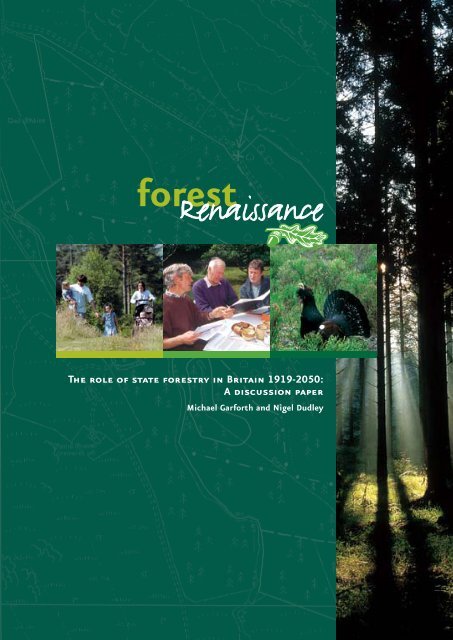
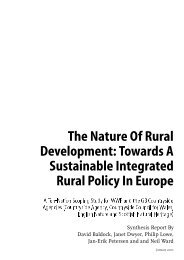
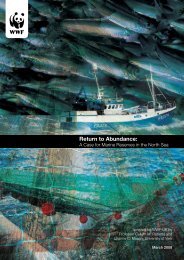
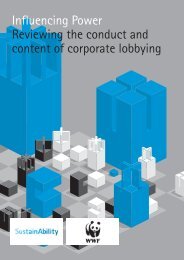
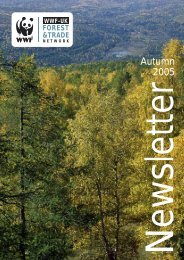

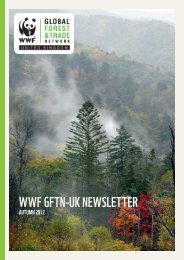


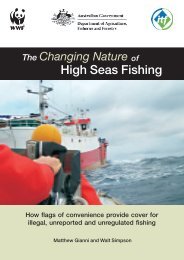
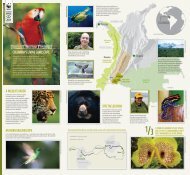
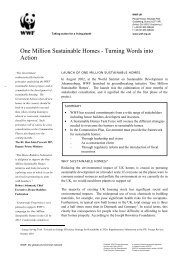
![[PDF] Causes for concern: chemicals and wildlife - WWF UK](https://img.yumpu.com/31929970/1/184x260/pdf-causes-for-concern-chemicals-and-wildlife-wwf-uk.jpg?quality=85)
